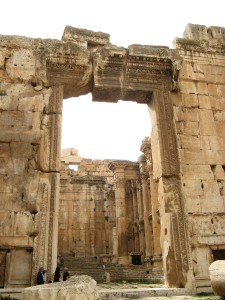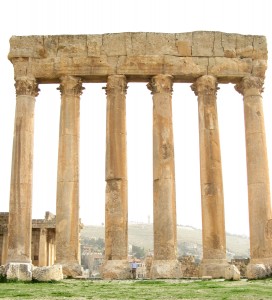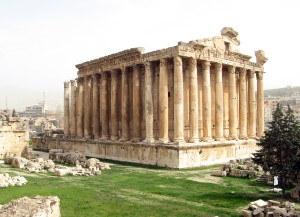I took a shared taxi over the border from Homs to Baalbek. There was some minor confusion at Syrian passport control: I hadn’t been issued an Entry Card when I entered Syria from Turkey and the Syrian immigration officer was duly aggrieved. But I mumbled some confused apologies, my taxi driver protested on my behalf (probably something along the lines of “he’s only a fool of a tourist”), there was some tapping on the computer, and I was duly sent onwards.
The land from the border to Baalbek looked relatively dry and dusty. There were no Hezbollah or militia checkpoints. I saw some Hezbollah billboards, but those were outnumbered by billboards of elegant young ladies advertising shampoo. (Hurrah!)
The Temple of Bacchus is much better preserved and still enormous. Most of the structure, including most of the external pillars and internal supports, is still standing. The main gateway has the famous “dropped keystone” at the top.
 |
The site had a steady trickle of visitors, but no large tour groups. There is a good site museum, which among much else explains how the largest stones were cut and moved. (One of the Roman tricks was inserting dry wooden wedges into a crack and then wetting them.)
Finally, I checked in to the distinctly eccentric Hotel Palmyra. I appeared to be the only guest. Following LonelyPlanet’s advice, I stayed in the supposedly better quality “extension”. However, this was unheated, was vaguely damp, had peeling paint, and no hot water. Sigh. I also had to collect the caretaker from the main entrance to open the annex door for me whenever I wanted in. But it was fine for one night.

